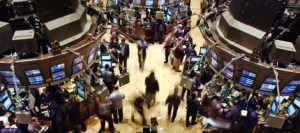
September 26, 2023 | AAPL, ADBE, ALB, AMAT, EUM, GOLD, LAC, Morning Briefing, MSFT, NVDA, PILBF, RWM, SCCO, Short Term, Special Reports, UUP, Volatility |
So what do you do with your portfolio for the rest of 2023? And what’s your best strategy to be prepared for 2024? In Part 1 of this Special Report I laid out the 10 developments that I thought would drive the financial markets for the rest of 223 and into 2024. Today, in Part 2, I’m going to give you the first 2 of 10 moves to take–with as much detail and as many specifics as possible–that you should be making now to position your portfolio for the uncertainties of the last quarter of 2023.

June 21, 2023 | Daily JAM, Videos |
Inflation deserves a bigger role in your portfolio. This vase of peonies reminds me of my first summer job: picking Japanese beetles off of my uncle’s peonies. He would offer what sounds like a not-so-generous salary of 25 cents per jar of dead beetles. But remember that’s 25 cents in 1960 or so. In thinking about inflation, I researched how much 25 cents in 1960 would be equivalent to today. 25 cents in 1960 amounts to $2.53 a jar. Still not terribly generous, but better. $100 in 1960 would be worth $1009 today, a ten-fold increase due to inflation. The Fed is still at work to stem inflation, but investors should note that there are some prices that the central bank can’t control. Inflation is built into the global climate economy with disruptions in agriculture, and new kinds of energy production (which will require higher costs), supply chain issues, not to mention that climate change is making some previously habitable places uninhabitable. All these problems will lead to extraordinary sources of inflation that are not susceptible to central bank policies. In order to hedge that inflation, make sure your portfolio, especially if it’s a long-term portfolio, has positions in things like gold or copper and lithium which will be in high demand and short supply in the next decade (at least.)

September 5, 2022 | Daily JAM, Special Reports |
Today, September 5, I’ve gone back through this Special Report to update any parts of my calendar in light of what we’ve learned about the economy, about Federal Reserve interest rate policy, and about the global economy in the last few weeks. This update includes my take on the August jobs report and on recent Fed-speak from the Jackson Hole conference and after. It is different this time. And it’s likely to “be different this time” for the next five years or so. And you need an investment strategy for that period.

October 2, 2021 | Daily JAM, Friday Trick or Trend |
Our regular (or occasional or perhaps occasionally regular) Friday series (actually running on Satur... To subscribe to JAM you need to fill in some details below including, ahem, some info on how you'll pay us. A subscription is $199 (although if you're subscribing...

July 6, 2021 | Daily JAM, Morning Briefing |
The Organization of Petroleum Exporting Countries and its affiliated oil producers (OPEC+) abandoned their Monday meeting after days of tense talks failed to result in an agreement on a tentative deal to increase production, and even over how to measure production. The disagreement between Saudi Arabia snd the United Arab Emirates was so heated that OPEC+ couldn’t even agree on a date for its next meeting. When these two countries last clashed in December 2020, the UAE talked of leaving OPEC. Oil prices initially jumped to its highest level in more than six years on news that OPEC+ had failed to agree to increase production. But prices then fell as traders speculated that the failure to reach an agreement on production increases would result in unplanned increases in production.

May 4, 2021 | Daily JAM, JJOFF, Volatility |
Researchers looking for a way to improve the tolerance of the Arabica coffee plant that accounts for 56% of global coffee production may have found their cuppa in Sierra Leone. Coffea stenophylla grows at a mean annual temperature up to 12.24 degrees higher than Arabica. And coffee tasters say, according to Bloomberg, it has a flavor similar to Arabica rather than to the more temperature tolerant Robusta coffee used now in instant and other bulk coffees. Global coffee production is threatened by rising temperatures

March 12, 2021 | Daily JAM, Volatility, WPM |
Before you get too excited by that headline, note that a 30% hike in the dividend at Wheaton Precious Metals (WPM) will bring the payout to just 13 cents for the first quarter of 2021. But that’s still, as my grandmother used to say, better than a poke in the eye with a sharp stick. At the least it’s a vote of confidence by the company’s board of directors that they see strong revenue and earnings growth in the year ahead. Wheaton Precious Metals doesn’t actually do any mining itself. Instead it purchases a stream of production from miners of precious metals and cobalt.

January 28, 2021 | AG, Daily JAM, DIS, FCX, FQVLF, GDX, GOLD, Jubak Picks, MGM, Morning Briefing, SCCO, Top 50 Stocks |
U.S. GDP growth slowed in the fourth quarter, gaining just 1% from the third quarter. For the full year the U.S. economy contracted by 3.5%. That makes 2020 the first time that the economy has contracted for a full year since 2009 and the Great Recession. At the bottom of that recession that economy contracted by 2.5%. 2020 is also the worst year for economic growth since 1946 when the economy shrank by 11.6% as the country demobilized after World War II. Consumer spending slowed in all 15 categories tracked by the Bureau of Economic Analysis. The sectors that had powered the recovery in the third quarter–restaurants and hotels, for instance–reversed. The growth in spending on cars and health car also slowed from the acceleration in the third quarter. So why is this good news as far as the stock market is concerned?

August 31, 2020 | BRK/B, Daily JAM, Jubak Picks, Stock Alerts |
Warren Buffet's Berkshire Hathaway (BRK-B) hit the headlines today on news that it had made a big buy in shares of Japanese trading companies. To me that looks like a typical Buffett value play on commodities and international trade at a time when the market in...

July 4, 2020 | Daily JAM, Short Term |
... a lot of data on commodities. You're excused if commodity prices haven't been on the top of mind lately. There have been a few other things to think about. So maybe you've missed some of the big moves in the sector. Copper, for example, has been up for seven...

June 14, 2018 | Daily JAM, Stock Alerts, Volatility, WPM |
Yesterday in Part 3 of my Special Report on "Investing in a Late Cycle Market" I made Wheaton Precious Metals (WPM) one of my "musical chairs" picks. Please note that I could have argued for buying this stock on its exposure to silver and gold. (Gold and silver will...

June 14, 2018 | Daily JAM, Notes You Need |
To subscribe to JAM you need to fill in some details below including, ahem, some info on how you'll pay us. A subscription is $199 (although if you're subscribing with one of our special offers it will be lower) for a year for ongoing and continuing access to the...













